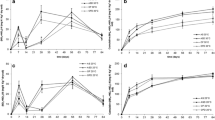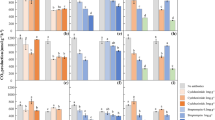Abstract
The effects of toluene on indigenous microbial populations involved in the soil nitrogen cycle were examined. Ammonia oxidation potential (AOP) and nitrite oxidation potential (NOP) were both reduced after incubation with high toluene concentrations for 45 days, with the former activity showing greater sensitivity. KCl-extractable ammonium (NH sup+sup4 ext) levels increased dramatically in soil exposed to high toluene levels, and arginine ammonification was not significantly affected. Alfalfa-amended soil incubated in the presence of 200 μg toluene ml−1 showed progressive accumulation of NH sup+inf4 ext over 37 days, indicating that mineralization of plant-associated nitrogen was not hindered by toluene. AOP in treated soil was much less than in control soil on days 7 and 37, but the MPN of ammonia oxidizers in control and exposed soil were not significantly different. Soil incubated with 100 µg toluene ml−1 for 28 days, vented and allowed to incubate for an additional 7 to 30 days, exhibited only slight increases in AOP and NOP, while NH sup+inf4 ext returned to control levels within a week. Soil exposed to 200 µg toluene ml−1 and treated in the same manner showed no increases in either AOP or NOP, and NH sup+inf4 ext remained elevated for the duration of the experiment, indicating more longterm effects on soil nitrogen cycling had occurred. Ammonia oxidizer levels in control soil and soil incubated with 100 µg toluene ml−1 were not appreciably different, whereas levels of ammonia oxidizers were very low in soil exposed to 200 µg toluene ml−1 and increased only slightly by 30 days post vent. Experiments to determine how toluene affects the AOP of soil indicated a competitive inhibition mechanism, with an effective concentration causing 50% reduction in activity (EC50) of 11 µM toluene, and a competitive inhibition constant (K) of 0.1 ± 0.05 µM toluene. These results indicate the potential for toluene to adversely impact nitrogen cycling in the terrestrial ecosystem by affecting indigenous soil nitrifiers, which are sensitive to lower levels of toluene than has been previously reported.
Similar content being viewed by others
References
Alef K, Kleiner D (1986) Arginine ammonification, a simple method to estimate microbial activity in soils. Soil Biol Biochem 18:233–235
Alef K, Kleiner D (1987) Applicability of arginine ammonification as an indicator of microbial activity in different soils. Biol Fert Soils 5:148–151
Azhar ES, Cleemput OV, Verstraete W (1989) The effect of sodium chlorate and nitrapyrin on the nitrification medicated nitrosation process in soils. Plant Soil 116:133–139
Bakelaar RG, Odum EP (1978) Community and population-level responses to fertilization in an old-field ecosystem. Ecology 59:660–665
Belser LW (1979) Population ecology of nitrifying bacteria. Annu Rev Microbiol 33:309–333
Belser LW, Mays EL (1980) Specific inhibition of nitrite oxidation by chlorate and its use in assessing nitrification in soils and sediments. Appl Environ Microbiol 39:505–510
Blair JM, Crossley DAJ, Rider S (1989) Effects of naphthalene on microbial activity and nitrogen pools in soil-litter microcosms. Soil Biol Biochem 21:507–510
Bloom AJ (1994) Crop acquisition of ammonium and nitrate. In: Boote KJ, Bennett JM, Sinclair TR, Paulsen GM (eds) Physiology and determination of crop yield. Am. Soc. Agron., Inc., Crop Sci. Soc. Am., Inc., and Soil Sci. Soc. Am., Inc., Madison, Wisconsin, pp 303–309
Blum DJW, Speece RE (1991) A database of chemical toxicity to environmental bacteria and its use in interspecies comparisons and correlations. Res J Wate Pollut Cont Fed 63:198–207
Bock E, Koops H, Harms H (1986) Cell biology of nitrifying bacteria. In: Prosser JI (ed) Nitrification. IRL Press, Washington, D.C., pp 17–38
Brock TD, Madigan MT (1988) Biology of microorganisms, 5th ed. Prentice Hall, Englewood Cliffs, New Jersey
Butt WD, Lees H (1960) Nitrite oxidation by Nitrobacter in the presence of certain nitrophenols. Nature 188:147–148
Carson WP, Barrett GW (1988) Succession in old-field plant communities: Effects of contrasting types of nutrient enrichment. Ecology 69:984–994
Carson WP, Pickett STA (1990) Role of resources and disturbance in the organization of an old-field plant community. Ecology 71:226–238
Chiang CY, Salanitro JP, Chai EY, Colthart JD, Klein CL (1989) Aerobic biodegradation of benzene, toluene, and xylene in a sandy aquifer-data analysis and computer modeling. Ground Water 27:823–834
Clarke KR, Owens NIP (1983) A simple and versatile microcomputer program for the determination of most probable number. J Microb Meth 1:133–137
Council NR (1993) In situ bioremediation: When does it work? National Academy Press, Washington, DC
Fan S, Scow KM (1993) Biodegradation of trichloroethylene and toluene by indigenous microbial populations in soil. Appl Environ Microbiol 59:1911–1918
Foster RC (1988) Microenvironments of soil microorganisms. Biol Fert Soils 6:189–203
Fuller ME, Scow KM (1996) Impacts of trichloroethylene (TCE) and toluene on nitrogen cycling in soil. Appl Environ Microbiol (submitted)
Fuller ME, Scow KM, Lau S, Ferris H (1996) Trichloroethylene (TCE) and toluene effects on the structure and function of the soil community. Soil Biol Biochem (in press)
Goldberg DE, Miller TE (1990) Effects of different resource additions on species diversity in an annual plant community. Ecology 71:213–225
Hansson GB, Klemedtsson L, Stenström J, Torstensson L (1991) Testing the influence of chemicals on soil autotrophic ammonium oxidation. Environ Toxicol Water Qual 6:351–360
Heil GW, Bruggink M (1987) Competition for nutrients between Calluna vulgaris (L.) Hull and Molinia caerulea (L.) Moench. Oecologia 73:105–107
Heil GW, Werger MJA, DeMol W, Van Dam D, Heijne B (1988) Capture of atmospheric ammonium by grassland canopies. Science 239:764–765
Hicks RJ, Stotzky G, van Voris P (1989) Review and evaluation of the effects of xenobiotic chemicals on microorganisms in soil. Adv Appl Microbiol 35:195–253
Holzman D (1995) Refractory chemical residues in soils may be safe. ASM News 61:445–446
Howard PJA, Howard DM (1991) Inhibition of nitrification by aqueous extracts of tree leaf litters. Rev Ecol Biol Sol 28:255–264
Huenneke LF, Hamburg SP, Koide R, Mooney HA, Vitousek PM (1990) Effects of soil resources on plant invasion and community structure in Californian serpentine grassland. Ecology 71:478–491
Kartikeyan S, Rao TP, Iyer CSP, Damodaran AD (1993) Spectrophotometric determination of traces of nitrite with rhodamine-6-G. Microchim Acta 111:193–198.
Keener WK, Arp DJ (1994) Transformations of aromatic compounds by Nitrosomonas europaea. Appl Environ Microbiol 60:1914–1920
Kroiss H, Schweighofer P, Frey W, Matsche N (1992) Nitrification inhibition-a source identification method for combined municipal and/or industrial wastewater treatment plants. Water Sci Technol 26:1135–1146
Lanza GR, Dougherty JM (1991) Microbial enzyme activity and biomass relationships in soil ecotoxicology. Environ Toxicol Water Qual 6:165–176
Lee MD, Butler WA, Mistretta TF, Zanikos IJ, Perkins RE (1994) Biological treatability studies on surface impoundment sludge from a chemical manufacturing facility. In: Hinchee RE, Leeson A, Semprini L, Ong SK (eds) Bioremediation of chlorinated and polycyclic aromatic hydrocarbon compounds. Lewis Publishers, Ann Arbor, Michigan, pp 129–143
Mathes K, Schulz-Berendt VM (1988) Ecotoxicological risk assessment of chemicals by measurements of nitrification combined with a computer simulation model of the N-cycle. Toxicol Assess 3:271–286
Meek ME, Chan PKL (1994) Toluene: Evaluation of risks to human health from environmental exposure in Canada. J Environ Sci Health 12:507–515
Mian MH (1989) Use of N-serve [2-chloro-6-(trichloromethyl) pyridine] to check nitrification of ammonium released from Azolla and blue-green algae in flooded soil. Agrochimica 33:159–163
Morgan P, Watkinson RJ (1990) Assessment of the potential for in situ biotreatment of hydrocarboncontaminated soils. Water Sci Technol 22:63–68
Mu DY, Scow KM (1994) Effect of trichloroethylene (TCE) and toluene concentrations on TCE and toluene biodegradation and the population density of TCE and toluene degraders in soil. Appl Environ Microbiol 60:2661–2665
Nelson MJK, Compeau GC, Maziarz T, Mahaffey WR (1994) Laboratory treatability testing for assessment of field applicability. In: Flathman PE, Jerger DE, Exner JH (eds) Bioremediation field experience. Lewis Publishers, Ann Arbor, Michigan, pp 59–77
Remde A, Hund K (1994) Response of soil autotrophic nitrification and soil respiration to chemical pollution in long-term experiments. Chemosphere 29:391–404
Rittmann BE, Seagren E, Wrenn BA, Valocchi AJ, Ray C, Raskin L (1994) In situ bioremediation, 2nd edn. Noyes Publications, Park Ridge, New Jersey
Sachanen AN (1955) Composition of synthetic and cracked gasolines. In: Brooks BT, Boord CE, Kurtz SSJ, Schmerling L (eds) The chemistry of petroleum hydrocarbons. Reinhold Publishing Corporation, New York, pp 61–70
Schmidt E, Belser L (1982) Nitrifying bacteria. In: Page A (ed) Methods of soil analysis, part 2: Chemical and microbiological properties, 2nd edn. Am. Soc. Agron, Inc., Crop Sci Soc Am, Inc., and Soil Sci Soc Am, Inc., Madison, Wisconsin, pp 1027–1042
Segel IH (1968) Biochemical calculations, 2nd edn. John Wiley & Sons, New York
Song H, Bartha R (1990) Effects of jet fuel spills on the microbial community of soil. Appl Environ Microbiol 56:646–651
Thomas JM, Gordy VR, Fiorenza S, Ward CH (1990) Biodegradation of BTEX in subsurface materials contaminated with gasoline: Granger, Indiana. Water Sci Technol 22:53–62
Wang W (1984) Time response of Nitrobacter to toxicity. Environ Int 10:21–26
Author information
Authors and Affiliations
Additional information
Correspondence to: K.M. Scow.
Rights and permissions
About this article
Cite this article
Fuller, M., Scowl, K. Effects of toluene on microbially-mediated processes involved in the soil nitrogen cycle. Microb Ecol 32, 171–184 (1996). https://doi.org/10.1007/BF00185886
Received:
Accepted:
Issue Date:
DOI: https://doi.org/10.1007/BF00185886




